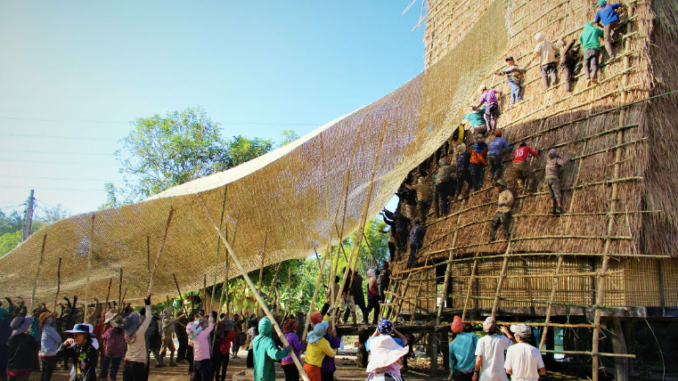
About 7 to 10 years, the Ba Na people replace the old thatched roof for the communal house, then they celebrate with can wine, sinus dance in the sound of gongs…

Located in the middle of Kon K’tu Community Tourism Village, Dak Ro Wa Commune (Kon Tum City) is a cultural communal house. The house faces south – the direction that brings luck and peace according to the Ba Na people’s concept.
If the communal house of the Gia Rai people has a thin, flat roof like the blade of an ax… then the communal house of the Ba Na people is larger, has softer contours and often has houses on stilts around.

Men sharpening bamboo prepare to roof the house. The communal house is a typical stilt house of the people of the Central Highlands, each village will have its own communal house. It is like the “heart” of the village, a place for gatherings, community activities, and important ceremonies. Usually, after construction is completed, about 7 to 10 years, people will replace the old thatched roof.

Alex (brown shirt), a French man who fell in love with the girl Ba Na became the child of the village, also participated in roofing.

The communal housework does not affect the productive labor of each family.

Solid clouds. The communal house does not use iron and steel, each joint is carefully cut, using rattan or bamboo to fasten.

The walls of the house are skillfully woven with bamboo and umbrellas to create vivid patterns.

Decorative pattern on bamboo. The stairs of the communal house usually have 7 to 9 steps, each ethnic group in the Central Highlands has a different decoration. The Ba Na people carve the tops of coriander plants on the walls and columns of the stairs.

Hundreds of people in the village work together to roof the roof. The characteristic of Ba Na people in the construction of communal houses is that they always work collectively, all work must be divided equally under the arrangement of the village elders.

Depending on the conditions and manpower of each village, building a communal house may take about 5 to 8 months.

After completing, the villagers will carry out stabbing buffaloes and slaughtering pigs to celebrate from 3 am. During the buffalo stabbing ceremony, “joar” – the gong song that transforms the life of the buffalo is played with a sinus rhythm, at the end of the song Joar, the offering – the buffalo becomes a sacred object to sacrifice to Yang (the deity). After the ceremony is over, young and old, boys and girls in the village will gather around the communal house to celebrate with can wine by the flickering fire.
